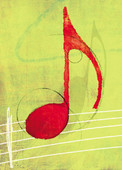
Home > Ear Training > Relative Pitch for Pianists
|
||||
Relative Pitch for Pianists
This skill is important because the distance between notes is what gives music the emotional qualities it possesses. If you play the C note and E note separately, they both sound fairly similar in terms of feel. The exact pitch would be different, but that does not convey anything. However, if you play the C note and then the E note, the E note has a happy, bright quality to it. That is because the E note is the major third of the C note. The relative pitch of the major third gives a bright, happy quality. If you play the G note and then the B note, the B note would have the same happy, bright quality to it because it is the major third of G. Even though, E and B are different notes, they convey the same feeling when they are the same relative pitch. The octave used in Western music consists of twelve evenly divided notes. The twelfth note, referred to as the “octave,” is the same note as the first note, except at a higher or lower pitch. If the two notes are played together, they are audibly the same note. Relative pitch involves being able to identify the distance from a specific note to the root note being used as a point of reference. Each relative pitch has a slightly different quality.
The relative pitch of the notes is what makes music sound the way it does. Even if you can identify every note in a song by ear, it does not tell you anything about how those notes relate to each other musically. Relative pitch for pianists is a vital skill, while absolute pitch serves no significant purpose. Songs can be played in different keys because of relative pitch. If the relative pitches between notes are all maintained, the song sounds the same. The overall pitch of each note may go up or down as a result of the key change, but that is usually not noticeable without listening to the song in different keys side by side. If you have a good knowledge of music theory, you can very easily play any song you know in whatever key you want. This can be a very useful skill for a pianist to learn. A pianist can play in whatever key he wants, but some instruments and vocalists can only perform in specific keys. The ability to change keys through relative pitch gives a lot more versatility to the pianist. Over time, most pianists naturally develop relative pitch. Repeatedly practicing the same parts over and over engrains the different pitches into your ear, making it easier to recognize them later on. Relative pitch for pianists and other musicians is very important in composition. Even if you do not consciously think you are using the skill, the entire idea of how songs are composed revolves around using relative pitch.
Check out Perfect Pitch Supercourse for the proven method of learning perfect pitch...
| ||||
|
Although every attempt has been made to make information as accurate as possible, we are not responsible for any errors that may appear.
 Relative pitch for pianists and other musicians is an important
aspect of
Relative pitch for pianists and other musicians is an important
aspect of 
 Relative pitch is often compared against absolute pitch, the ability to
identify the exact pitch of the note. Many people believe that absolute pitch is a very useful skill for
musicians. The reality is absolute pitch is nearly useless. As the above example shows, the exact pitch of
notes does not convey anything musically.
Relative pitch is often compared against absolute pitch, the ability to
identify the exact pitch of the note. Many people believe that absolute pitch is a very useful skill for
musicians. The reality is absolute pitch is nearly useless. As the above example shows, the exact pitch of
notes does not convey anything musically.



